lock FORD SUPER DUTY 2008 2.G Special Off-Road Package Supplement Manual
[x] Cancel search | Manufacturer: FORD, Model Year: 2008, Model line: SUPER DUTY, Model: FORD SUPER DUTY 2008 2.GPages: 25, PDF Size: 0.2 MB
Page 6 of 25
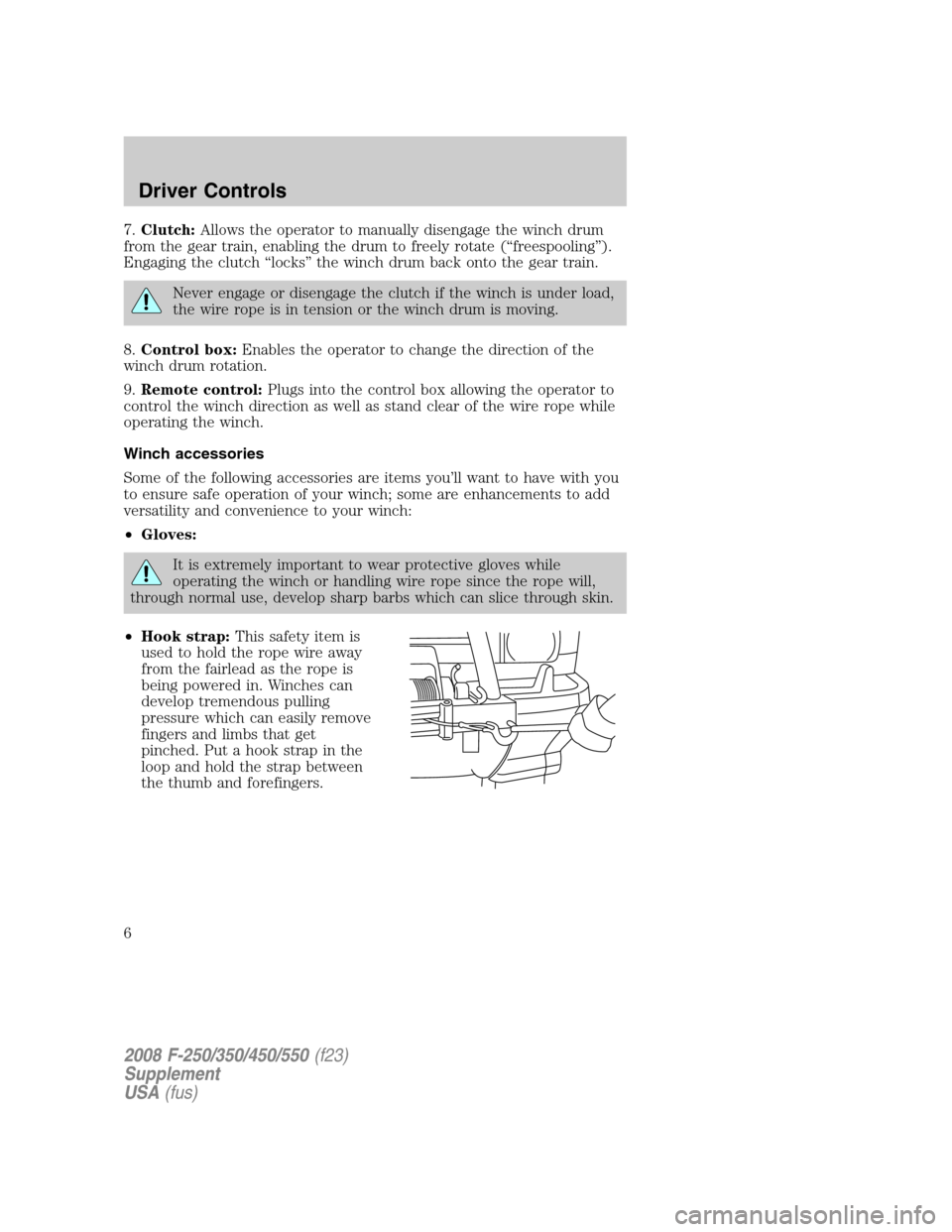
7.Clutch:Allows the operator to manually disengage the winch drum
from the gear train, enabling the drum to freely rotate (“freespooling”).
Engaging the clutch “locks” the winch drum back onto the gear train.
Never engage or disengage the clutch if the winch is under load,
the wire rope is in tension or the winch drum is moving.
8.Control box:Enables the operator to change the direction of the
winch drum rotation.
9.Remote control:Plugs into the control box allowing the operator to
control the winch direction as well as stand clear of the wire rope while
operating the winch.
Winch accessories
Some of the following accessories are items you’ll want to have with you
to ensure safe operation of your winch; some are enhancements to add
versatility and convenience to your winch:
•Gloves:
It is extremely important to wear protective gloves while
operating the winch or handling wire rope since the rope will,
through normal use, develop sharp barbs which can slice through skin.
•Hook strap:This safety item is
used to hold the rope wire away
from the fairlead as the rope is
being powered in. Winches can
develop tremendous pulling
pressure which can easily remove
fingers and limbs that get
pinched. Put a hook strap in the
loop and hold the strap between
the thumb and forefingers.
2008 F-250/350/450/550(f23)
Supplement
USA(fus)
Driver Controls
6
Page 9 of 25

becomes the anchor point. In this case, be sure to put the transmission
in neutral, apply the parking brake and block the wheels to prevent it
from moving.
The anchor point should allow you to pull straight in the direction the
vehicle will move. This allows the rope to wind tightly and evenly on the
winch drum. An anchor point as far away as possible will provide the
winch with its greatest pulling power.
Winching hand signals
In some situations, recovery could involve two people. While one person
drives, the other person provides navigation assistance and ensures the
rope is winding properly. Understanding the right hand signals help
provide clear understanding between the driver and the navigator. Also,
if the driver controlling the winch can not see both hands of the
navigator, the winch should not be activated. The following are some
suggested hand signals to review:
1. Hold your arms out with thumbs up and tilt your hands in the
direction you advise the driver to steer.
2. Hold your forefinger in the air above your shoulder height and draw
small circles in the air to indicate to wind the winch.
2008 F-250/350/450/550(f23)
Supplement
USA(fus)
Driver Controls
9
Page 10 of 25
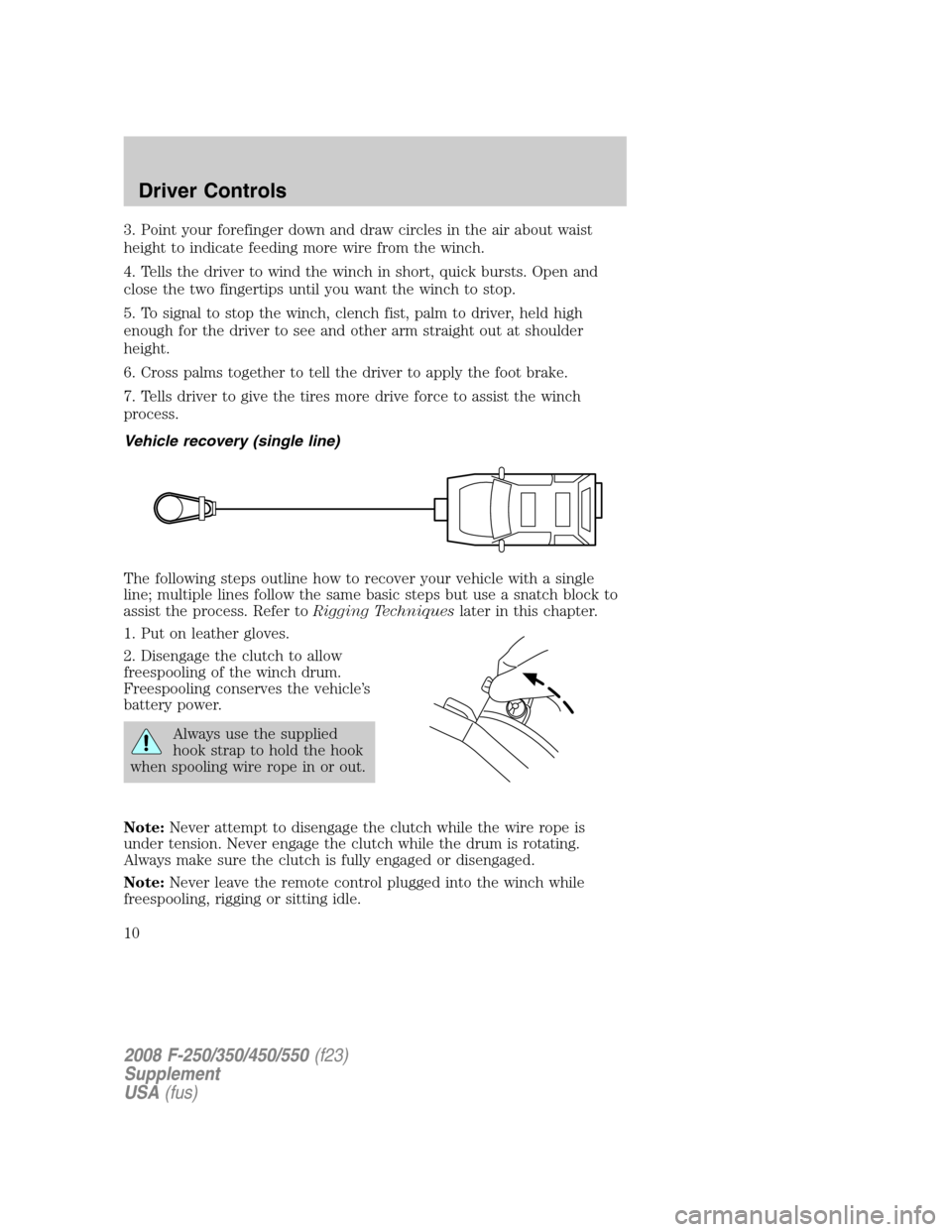
3. Point your forefinger down and draw circles in the air about waist
height to indicate feeding more wire from the winch.
4. Tells the driver to wind the winch in short, quick bursts. Open and
close the two fingertips until you want the winch to stop.
5. To signal to stop the winch, clench fist, palm to driver, held high
enough for the driver to see and other arm straight out at shoulder
height.
6. Cross palms together to tell the driver to apply the foot brake.
7. Tells driver to give the tires more drive force to assist the winch
process.
Vehicle recovery (single line)
The following steps outline how to recover your vehicle with a single
line; multiple lines follow the same basic steps but use a snatch block to
assist the process. Refer toRigging Techniqueslater in this chapter.
1. Put on leather gloves.
2. Disengage the clutch to allow
freespooling of the winch drum.
Freespooling conserves the vehicle’s
battery power.
Always use the supplied
hook strap to hold the hook
when spooling wire rope in or out.
Note:Never attempt to disengage the clutch while the wire rope is
under tension. Never engage the clutch while the drum is rotating.
Always make sure the clutch is fully engaged or disengaged.
Note:Never leave the remote control plugged into the winch while
freespooling, rigging or sitting idle.
2008 F-250/350/450/550(f23)
Supplement
USA(fus)
Driver Controls
10
Page 11 of 25
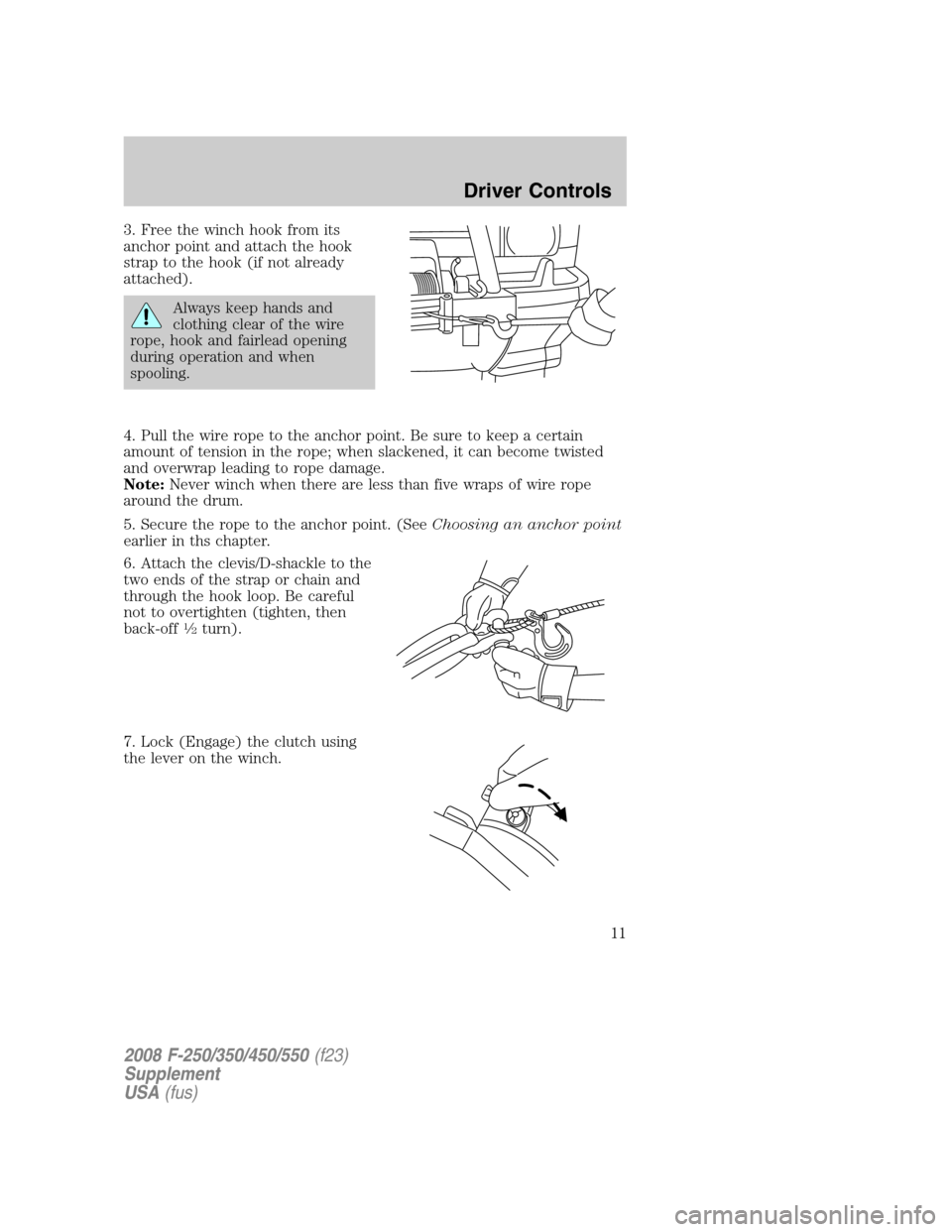
3. Free the winch hook from its
anchor point and attach the hook
strap to the hook (if not already
attached).
Always keep hands and
clothing clear of the wire
rope, hook and fairlead opening
during operation and when
spooling.
4. Pull the wire rope to the anchor point. Be sure to keep a certain
amount of tension in the rope; when slackened, it can become twisted
and overwrap leading to rope damage.
Note:Never winch when there are less than five wraps of wire rope
around the drum.
5. Secure the rope to the anchor point. (SeeChoosing an anchor point
earlier in ths chapter.
6. Attach the clevis/D-shackle to the
two ends of the strap or chain and
through the hook loop. Be careful
not to overtighten (tighten, then
back-off
1�2turn).
7. Lock (Engage) the clutch using
the lever on the winch.
2008 F-250/350/450/550(f23)
Supplement
USA(fus)
Driver Controls
11
Page 14 of 25

How to spool under no load
Arrange the remote control lead so it cannot be caught in the winch.
Arrange the wire rope so it will not kink or tangle when spooled. Be sure
any wire rope already on the spooling drum is wound tightly and evenly
layered (unspool and tighten and layer evenly, if necessary). Keep the
wire rope under light tension and spool the wire rope back onto the
winch drum in even layers. Stop frequently to tighten and straighten the
layers as necessary. Repeat this process until the winch hook is the same
distance as the full length of the remote control from the winch. Attach
the hook strap, then walk the wire rope toward the fairlead, carefully
spooling in the remaining rope by pulsing the remote control switch.
Store the hook at the fairlead or tensioned to a suitable location to the
side.
If you do not have the hook strap, use a length of cord or something
similar.
To help prevent serious injury,neverput your fingers inside the
hook area as you are powering in.
Rigging techniques
Various winching situations will require unique winching techniques.
These could range from too little distance to achieve maximum pull
using straight line rigging, simply increasing pulling power or maintaining
a straight-line pulling situation.
How to change the pulling direction
All winching operations should have
a straight line from the winch to the
object being pulled. This minimizes
the wire rope collecting on one side
of the drum which will affect pulling
efficiency and may damage the wire
rope. A snatch block, secured to a
point directly in front of the vehicle,
enables you to change the pulling
direction while allowing the wire
rope to be at 90° to wind properly
onto the drum.
2008 F-250/350/450/550(f23)
Supplement
USA(fus)
Driver Controls
14
Page 15 of 25
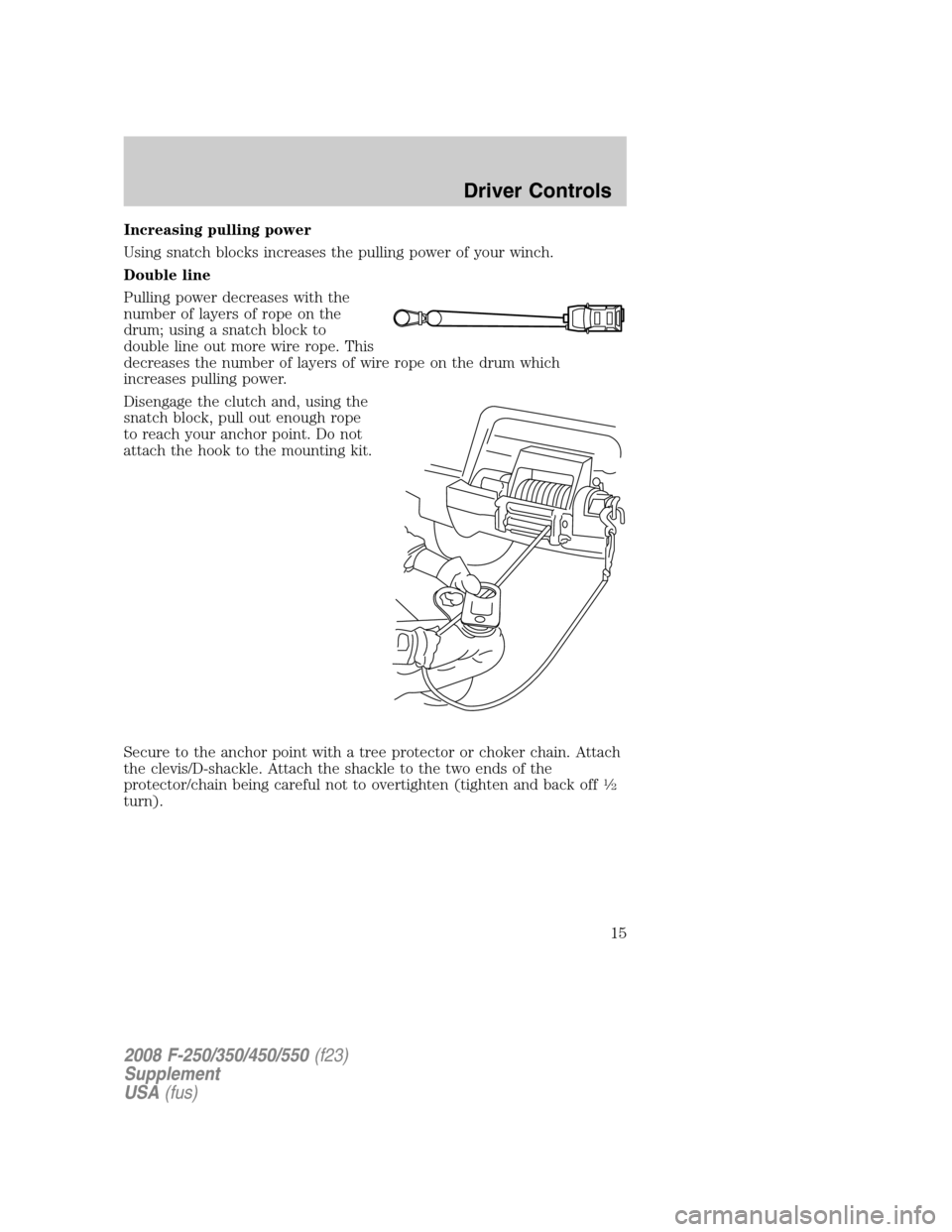
Increasing pulling power
Using snatch blocks increases the pulling power of your winch.
Double line
Pulling power decreases with the
number of layers of rope on the
drum; using a snatch block to
double line out more wire rope. This
decreases the number of layers of wire rope on the drum which
increases pulling power.
Disengage the clutch and, using the
snatch block, pull out enough rope
to reach your anchor point. Do not
attach the hook to the mounting kit.
Secure to the anchor point with a tree protector or choker chain. Attach
the clevis/D-shackle. Attach the shackle to the two ends of the
protector/chain being careful not to overtighten (tighten and back off
1�2
turn).
2008 F-250/350/450/550(f23)
Supplement
USA(fus)
Driver Controls
15
Page 16 of 25
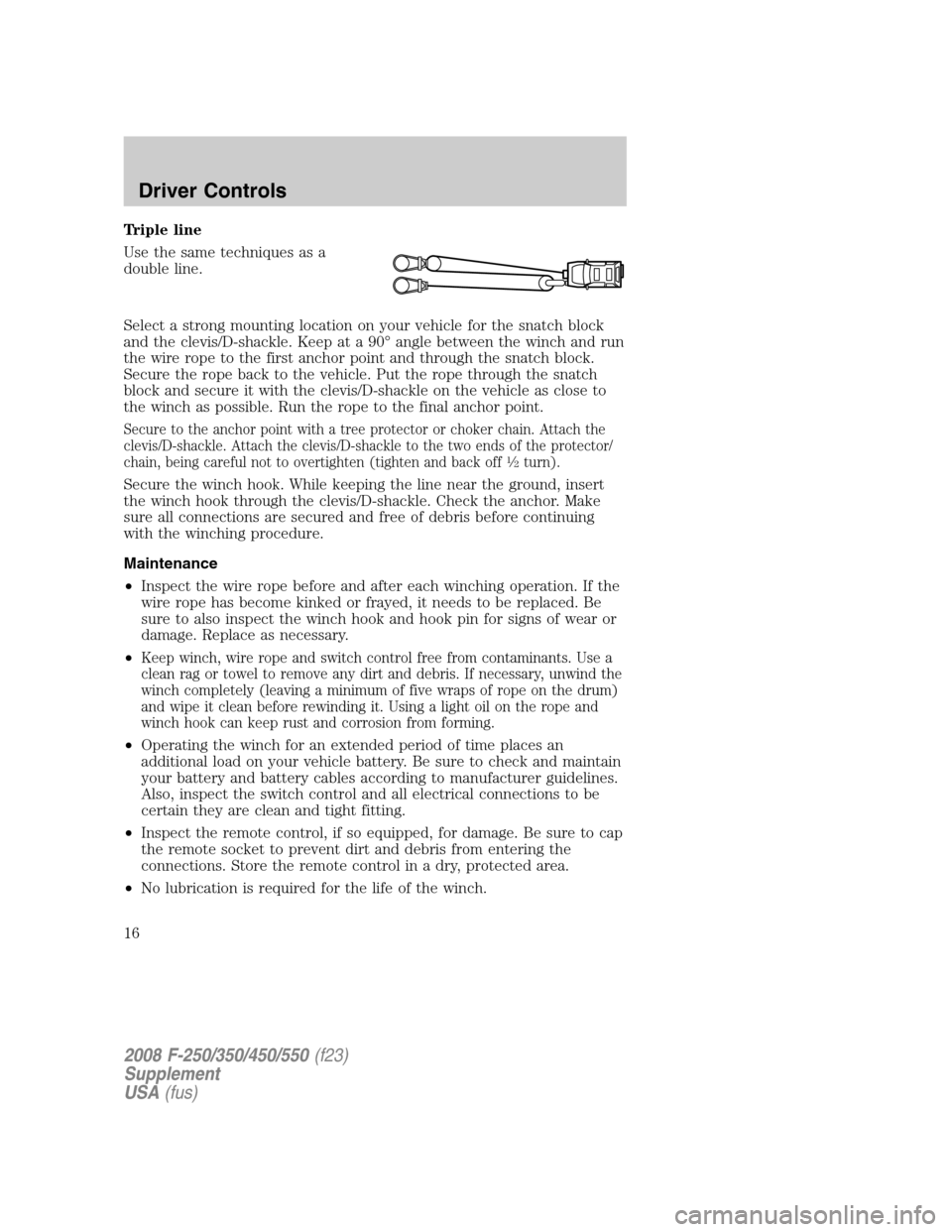
Triple line
Use the same techniques as a
double line.
Select a strong mounting location on your vehicle for the snatch block
and the clevis/D-shackle. Keep at a 90° angle between the winch and run
the wire rope to the first anchor point and through the snatch block.
Secure the rope back to the vehicle. Put the rope through the snatch
block and secure it with the clevis/D-shackle on the vehicle as close to
the winch as possible. Run the rope to the final anchor point.
Secure to the anchor point with a tree protector or choker chain. Attach the
clevis/D-shackle. Attach the clevis/D-shackle to the two ends of the protector/
chain, being careful not to overtighten (tighten and back off
1�2turn).
Secure the winch hook. While keeping the line near the ground, insert
the winch hook through the clevis/D-shackle. Check the anchor. Make
sure all connections are secured and free of debris before continuing
with the winching procedure.
Maintenance
•Inspect the wire rope before and after each winching operation. If the
wire rope has become kinked or frayed, it needs to be replaced. Be
sure to also inspect the winch hook and hook pin for signs of wear or
damage. Replace as necessary.
•
Keep winch, wire rope and switch control free from contaminants. Use a
clean rag or towel to remove any dirt and debris. If necessary, unwind the
winch completely (leaving a minimum of five wraps of rope on the drum)
and wipe it clean before rewinding it. Using a light oil on the rope and
winch hook can keep rust and corrosion from forming.
•Operating the winch for an extended period of time places an
additional load on your vehicle battery. Be sure to check and maintain
your battery and battery cables according to manufacturer guidelines.
Also, inspect the switch control and all electrical connections to be
certain they are clean and tight fitting.
•Inspect the remote control, if so equipped, for damage. Be sure to cap
the remote socket to prevent dirt and debris from entering the
connections. Store the remote control in a dry, protected area.
•No lubrication is required for the life of the winch.
2008 F-250/350/450/550(f23)
Supplement
USA(fus)
Driver Controls
16
Page 18 of 25

ANTI-LOCK BRAKE SYSTEM (ABS) DEACTIVATION IN 4WD
(IF EQUIPPED)
Refer to the label on the back of the sun visor mirror regarding Anti-lock
Brake System (ABS) operation.
Your vehicle’s Anti-lock Brake System (ABS) may be designed to
deactivate when 4WD Low is engaged. The ABS indicator (
ABS)
illuminates and stays on, to indicate that ABS is deactivated, as long as
4WD Low is engaged.
When 4WD Low is disengaged, the ABS light turns off and the system is
active again.
SUSPENSION UPGRADE PACKAGE
Your vehicle is equipped with a special suspension package that will
enhance the vehicle’s off-road performance. The vehicle will handle
differently, both on and off-road, from a factory-equipped passenger car
or truck.
Vehicles with a higher center of gravity such as utility and
four-wheel drive vehicles handle differently than vehicles with a
lower center of gravity. Utility and four-wheel drive vehicles are not
designed for cornering at speeds as high as passenger cars any more
than low-slung sports cars are designed to perform satisfactorily under
off-road conditions. Avoid sharp turns, excessive speed and abrupt
maneuvers in these vehicles. Failure to drive cautiously could result in
an increased risk of loss of vehicle control, vehicle rollover, personal
injury and death.
If the vehicle is not equipped with in-cab suspension controls, the shock
settings are preset and not adjustable inside the vehicle. Contact your
authorized technician to make any necessary adjustments. Maximum
pressure is 15 psi for off-road operation with maximum load.
2008 F-250/350/450/550(f23)
Supplement
USA(fus)
Driving
18
Page 20 of 25
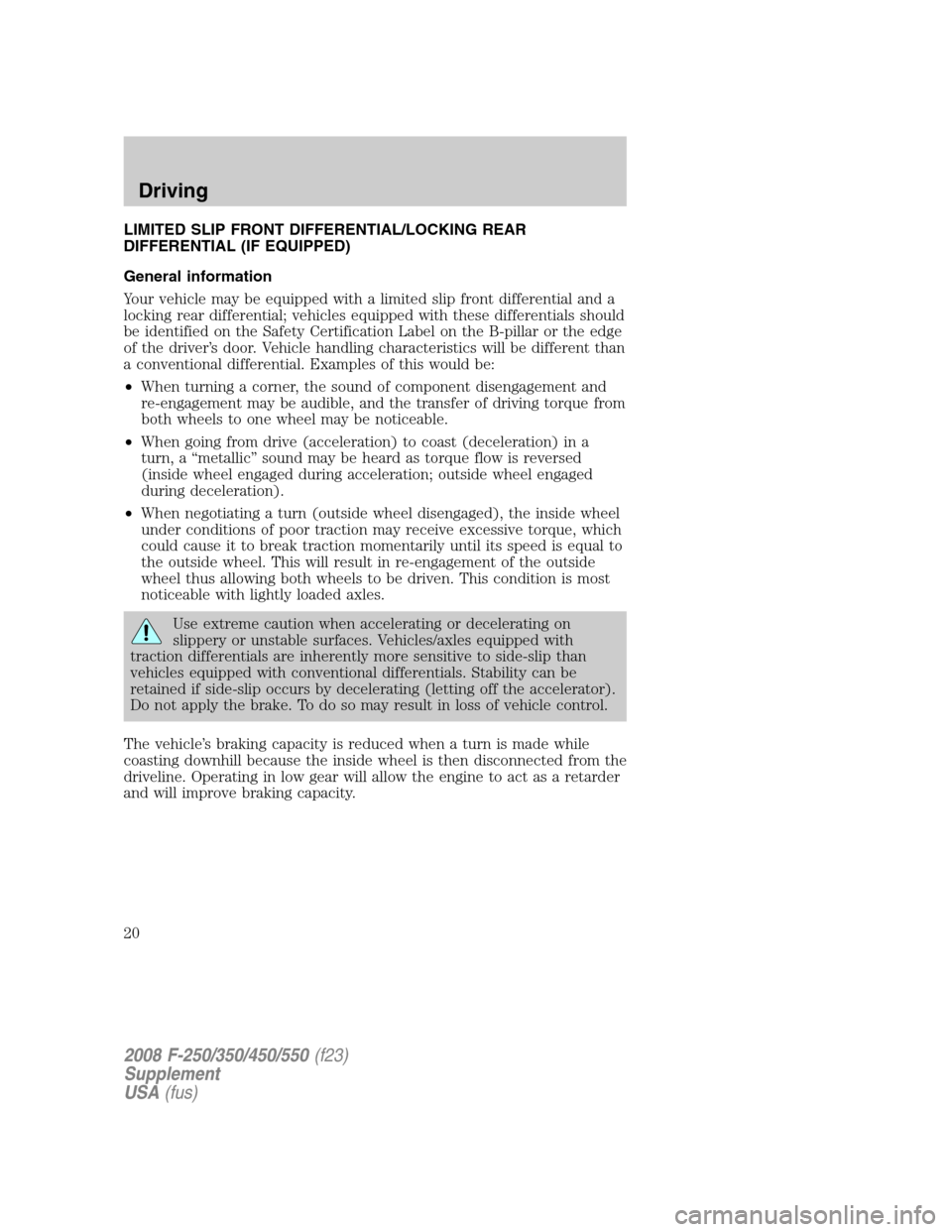
LIMITED SLIP FRONT DIFFERENTIAL/LOCKING REAR
DIFFERENTIAL (IF EQUIPPED)
General information
Your vehicle may be equipped with a limited slip front differential and a
locking rear differential; vehicles equipped with these differentials should
be identified on the Safety Certification Label on the B-pillar or the edge
of the driver’s door. Vehicle handling characteristics will be different than
a conventional differential. Examples of this would be:
•When turning a corner, the sound of component disengagement and
re-engagement may be audible, and the transfer of driving torque from
both wheels to one wheel may be noticeable.
•When going from drive (acceleration) to coast (deceleration) in a
turn, a “metallic” sound may be heard as torque flow is reversed
(inside wheel engaged during acceleration; outside wheel engaged
during deceleration).
•When negotiating a turn (outside wheel disengaged), the inside wheel
under conditions of poor traction may receive excessive torque, which
could cause it to break traction momentarily until its speed is equal to
the outside wheel. This will result in re-engagement of the outside
wheel thus allowing both wheels to be driven. This condition is most
noticeable with lightly loaded axles.
Use extreme caution when accelerating or decelerating on
slippery or unstable surfaces. Vehicles/axles equipped with
traction differentials are inherently more sensitive to side-slip than
vehicles equipped with conventional differentials. Stability can be
retained if side-slip occurs by decelerating (letting off the accelerator).
Do not apply the brake. To do so may result in loss of vehicle control.
The vehicle’s braking capacity is reduced when a turn is made while
coasting downhill because the inside wheel is then disconnected from the
driveline. Operating in low gear will allow the engine to act as a retarder
and will improve braking capacity.
2008 F-250/350/450/550(f23)
Supplement
USA(fus)
Driving
20
Page 21 of 25
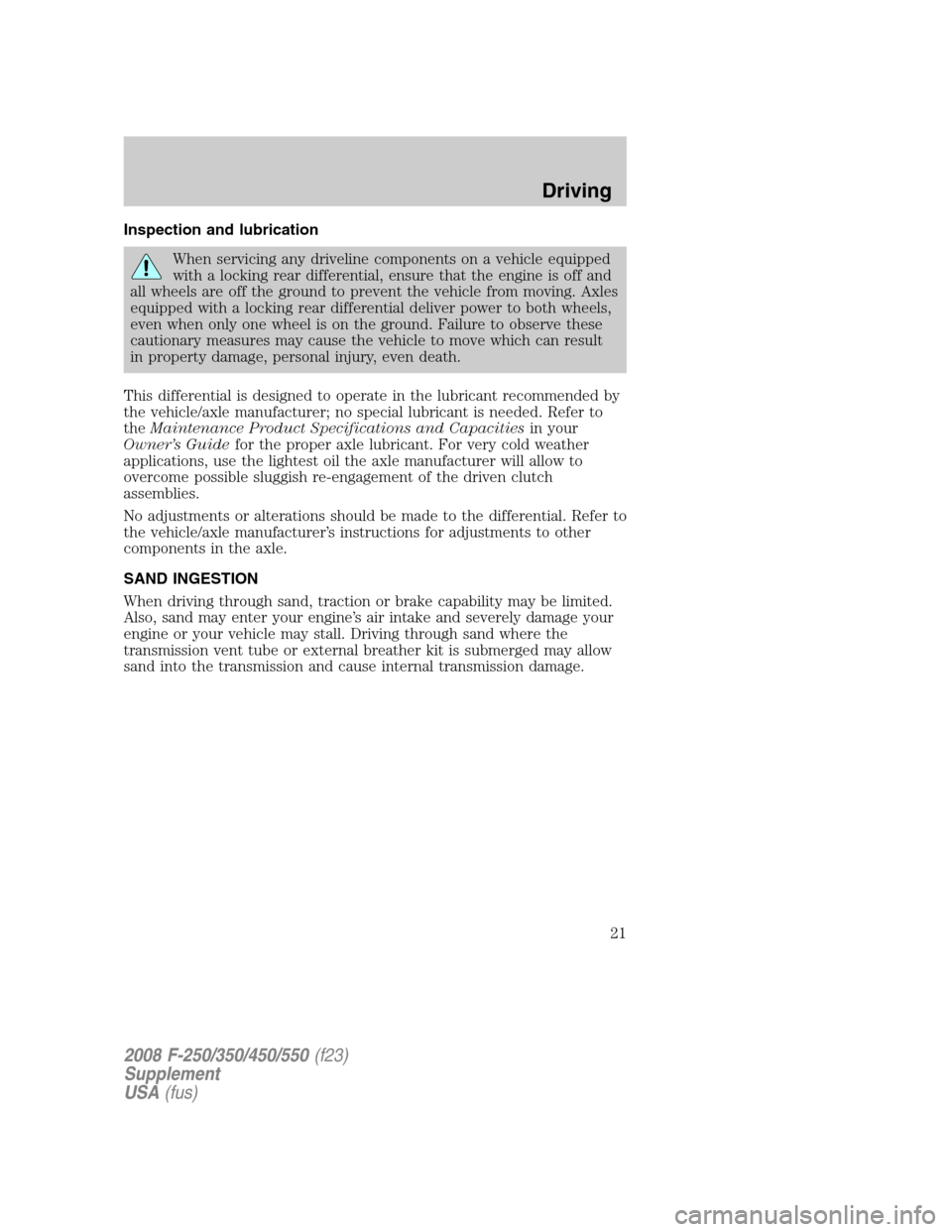
Inspection and lubrication
When servicing any driveline components on a vehicle equipped
with a locking rear differential, ensure that the engine is off and
all wheels are off the ground to prevent the vehicle from moving. Axles
equipped with a locking rear differential deliver power to both wheels,
even when only one wheel is on the ground. Failure to observe these
cautionary measures may cause the vehicle to move which can result
in property damage, personal injury, even death.
This differential is designed to operate in the lubricant recommended by
the vehicle/axle manufacturer; no special lubricant is needed. Refer to
theMaintenance Product Specifications and Capacitiesin your
Owner’s Guidefor the proper axle lubricant. For very cold weather
applications, use the lightest oil the axle manufacturer will allow to
overcome possible sluggish re-engagement of the driven clutch
assemblies.
No adjustments or alterations should be made to the differential. Refer to
the vehicle/axle manufacturer’s instructions for adjustments to other
components in the axle.
SAND INGESTION
When driving through sand, traction or brake capability may be limited.
Also, sand may enter your engine’s air intake and severely damage your
engine or your vehicle may stall. Driving through sand where the
transmission vent tube or external breather kit is submerged may allow
sand into the transmission and cause internal transmission damage.
2008 F-250/350/450/550(f23)
Supplement
USA(fus)
Driving
21